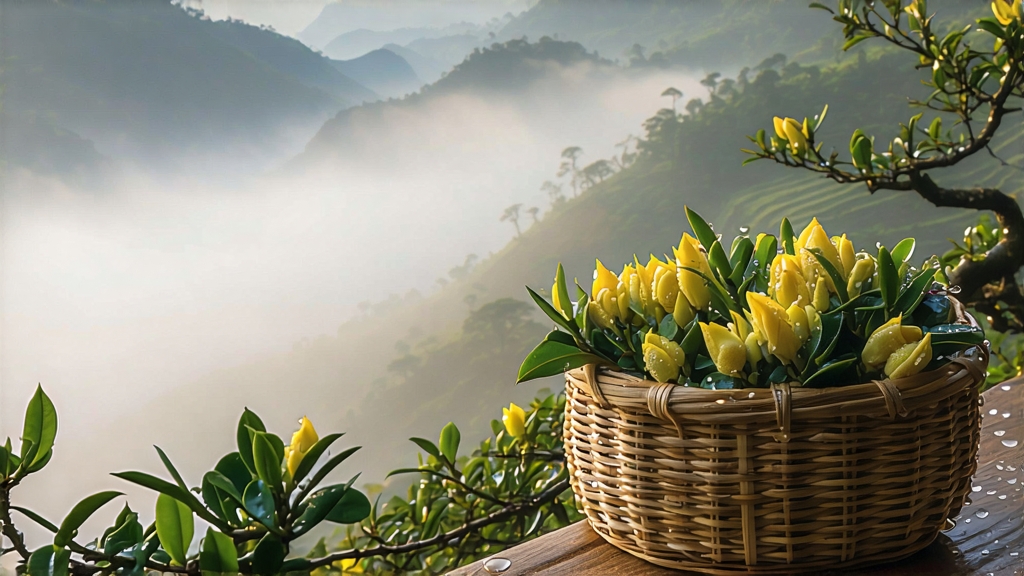
Tucked high on the northern rim of the Sichuan Basin, where the Tibetan Plateau exhales cool, mineral-laden clouds toward the Yangtze gorge, lies Meng Ding Mountain—Meng Shan for short. At elevations between 800 and 1 450 m, the peak is permanently wrapped in a slow-moving veil of fog that shortens sunlight to a soft, diffused glow and keeps nighttime temperatures mild. These conditions force the tea plant to synthesize more amino acids and fewer bitter catechins, giving the local leaf its signature sweetness. Among the four earliest recorded tea gardens of China—Meng Shan, Gu Zhu, Gu Zhang, and Qi Men—Meng Shan is the only one still producing a yellow tea today: Meng Ding Huang Ya, literally “Yellow Bud from the Summit of Meng.”
Although yellow tea as a processing category was first documented in the Tang dynasty (618-907 CE), Meng Ding Huang Ya did not acquire its “yellow” identity until the Ming (1368-1644). Prior to that it was a steamed green cake tribute known as “Shi Hua” (Stone Flower), pressed into small molds and freighted down the Min River to Chang’an. When the Hongwu Emperor abolished compressed tea in 1391, mountain monks and court-appointed tea masters experimented with slow, humid oxidation to keep the loose leaf from turning grassy during the long, hot journey to Beijing. The accidental discovery that a gentle, post-fixation “sealed yellowing” (men huang) mellowed the liquor and added a honeyed corn note became the defining innovation of yellow tea. By the Qianlong reign (1736-1795) Meng Ding Huang Ya was listed among the “Ten Best Tributes,” arriving at the Forbidden City in small bamboo tubes sealed with red wax and imperial calligraphy.
Modern classification divides Meng Ding Huang Ya into three grades based on picking standard and yellowing depth:
1) Jade Bud (yu ya) – one bud only, picked before Qingming, 6–8 hours of yellowing, palest liquor, orchid aroma.
2) Gold Bud (jin ya) – one bud and one unfolded leaf, 8–10 hours of yellowing, balanced sweetness, hint of raw walnut.
3) Crown Bud (guan ya) – one bud and two leaves, 10–12 hours of yellowing, fuller body, notes of steamed pumpkin and wet basalt.
All grades share the same cultivar—Meng Shan Qun Ti Zhong, a seed-propagated landrace whose roots can exceed two metres, anchoring the plant to the steep, granite-derived slopes. Because the mountain is a protected heritage site, no clonal hybrids or chemical fertilisers are permitted; every garden is inter-cropped with wild bamboo, ginkgo, and fragrant osmanthus to maintain biodiversity.
Crafting Meng Ding Huang Ya is a six-step ritual that unfolds over four consecutive days and is still guided by the mountain’s lunar calendar.
-
Plucking: Picking begins at dawn when the leaf surface temperature is below 18 °C and moisture exceeds 78 %. Only buds whose tip has just “opened its fish-eye”—the first tiny semi-transparent scale—are snapped sideways with the nail to avoid bruising. A skilled picker gathers barely 400 g per hour.
-
Shade Withering: The leaf is laid in single layers on bamboo trays inside darkened sheds where mountain wind is filtered through wet reed curtains. Over 3–4 hours the leaf loses about 10 % moisture, turning velvety to the touch while internal grassiness dissipates.
-
Pan-Fixation: Using Meng Shan’s iconic “double-skin” wok—cast iron nested inside a clay ring—tea masters flash-roast the leaf at 180 °C for 90 seconds, then drop to 120 °C for another three minutes. The goal is to deactivate polyphenol oxidase while preserving the yellowing potential of soluble sugars.
-
Sealed Yellowing: Immediately after fixation, the hot leaf is scooped into thick linen sacks and buried inside a pine-lined wooden box. The box is slid into a cave-like chamber kept at 35 °C and 85 % relative humidity for 6–12 hours depending on grade. During this “sweat” the residual enzymes convert chlorophyllides into pheophytins, turning the leaf colour from vivid green to muted jade with golden edges. The process is checked every 30 minutes; if the core temperature exceeds 40 °C the box is opened to prevent